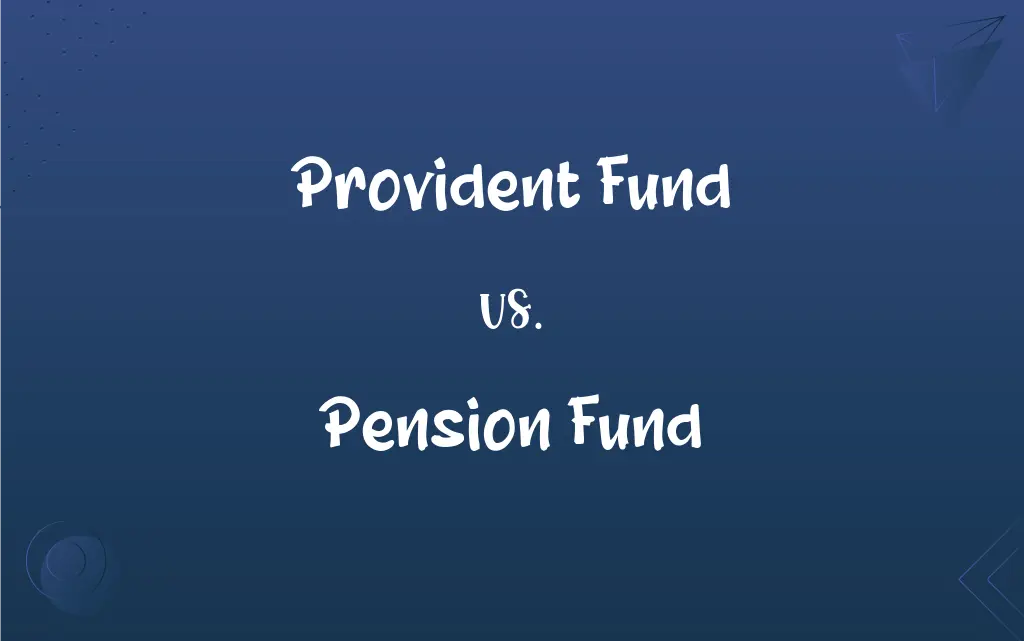Provident Fund vs. Pension Fund: What's the Difference?
Edited by Aimie Carlson || By Janet White || Published on November 11, 2023
Provident Fund is a savings scheme for employees to contribute a portion of their salaries, while Pension Fund provides regular income post-retirement.

Key Differences
Provident Fund is a mandatory savings mechanism where both the employee and employer contribute a part of the salary, ensuring a lump sum upon retirement. On the other hand, Pension Fund is structured primarily to offer beneficiaries a steady income stream after their working years.
Under the Provident Fund, members can usually withdraw the entire accumulated amount at once upon retirement or under certain conditions, while Pension Fund typically disburses amounts periodically, ensuring long-term financial security.
The main objective of the Provident Fund is to cultivate savings habits among employees, giving them a financial cushion. Conversely, Pension Fund aims to maintain retirees' standard of living by replacing a portion of their pre-retirement income.
Provident Fund contributions might be fixed, often a percentage of the salary, with the accumulated amount including both principal and interest. Pension Fund, in contrast, focuses on the final benefit, with contributions adjusted to ensure the promised pension.
Tax benefits related to Provident Fund and Pension Fund can differ, with many jurisdictions offering incentives to promote retirement savings. However, Provident Funds might have more lenient withdrawal rules compared to Pension Funds, which prioritize long-term stability.
ADVERTISEMENT
Comparison Chart
Purpose
Encourages savings for future financial security.
Provides steady post-retirement income.
Nature of Withdrawal
Typically allows lump-sum withdrawals.
Focuses on periodic disbursements.
Contribution Mechanism
Fixed contributions, often a salary percentage.
Aimed at ensuring a promised pension.
Objective
Cultivate saving habits among employees.
Maintain retirees' standard of living.
Tax Benefits & Withdrawal Rules
Might offer tax benefits, with lenient withdrawal terms.
Tax incentives with stricter withdrawal conditions for stability.
ADVERTISEMENT
Provident Fund and Pension Fund Definitions
Provident Fund
Provident Fund is a compulsory savings scheme for employees.
John's monthly salary has a small deduction for the Provident Fund.
Pension Fund
Pension Fund is designed to offer post-retirement income.
After retiring, Mr. Smith received monthly payouts from his Pension Fund.
Provident Fund
Provides financial security for retirement or emergencies.
After 30 years of service, Linda accessed her Provident Fund for a comfortable retirement.
Pension Fund
Provides long-term financial security with periodic disbursements.
Despite having no other income, Jenny's Pension Fund allowed her a decent life.
Provident Fund
Both employee and employer contribute to the fund.
The company matches Mary's Provident Fund contributions.
Pension Fund
Often comes with tax incentives and stricter withdrawal rules.
Jack couldn't easily access his Pension Fund early due to stringent conditions.
Provident Fund
Accumulated amounts include contributions plus interest.
The interest rate made Paul's Provident Fund grow significantly over time.
Pension Fund
Focuses on replacing a part of an individual's pre-retirement earnings.
The Pension Fund ensures retirees like Mrs. Davis maintain their lifestyle.
Provident Fund
Can offer tax benefits and relatively flexible withdrawal conditions.
Sara withdrew from her Provident Fund for her daughter's education without hefty penalties.
Pension Fund
Contributions are structured to meet the promised pension benefit.
Contributions to Tom's Pension Fund increased to keep up with his promised payout.
FAQs
How is a Pension Fund's payout structured?
It's typically a periodic payment, like monthly or annually.
What's the primary goal of a Provident Fund?
To foster savings habits and provide financial security.
Are both the Provident Fund and Pension Fund mandatory?
It varies by country; some have mandatory schemes, while others are voluntary.
Can I access my Provident Fund before retirement?
Usually, under certain conditions like emergencies or specific milestones.
Can I borrow against my Provident Fund?
Some plans allow loans, but terms and conditions apply.
Can I decide my Provident Fund contribution amount?
Typically, it's a fixed percentage, but some plans might allow flexibility.
How does a Pension Fund offer long-term stability?
By ensuring periodic payouts, reducing lump-sum withdrawals.
Who manages Pension Funds?
Professional fund managers to maximize returns and ensure stability.
How do contributions to Provident Fund accumulate?
Through both employee and employer contributions plus interest.
How do Pension Fund payouts change over time?
They might adjust with inflation or fund performance.
What drives Pension Fund contributions?
The goal of providing the promised post-retirement income.
Is the interest from Provident Fund taxable?
Tax treatments vary, but many jurisdictions offer tax benefits.
Why are Pension Funds considered more stable?
Due to their structured payouts and long-term focus.
About Author
Written by
Janet WhiteJanet White has been an esteemed writer and blogger for Difference Wiki. Holding a Master's degree in Science and Medical Journalism from the prestigious Boston University, she has consistently demonstrated her expertise and passion for her field. When she's not immersed in her work, Janet relishes her time exercising, delving into a good book, and cherishing moments with friends and family.
Edited by
Aimie CarlsonAimie Carlson, holding a master's degree in English literature, is a fervent English language enthusiast. She lends her writing talents to Difference Wiki, a prominent website that specializes in comparisons, offering readers insightful analyses that both captivate and inform.








































































